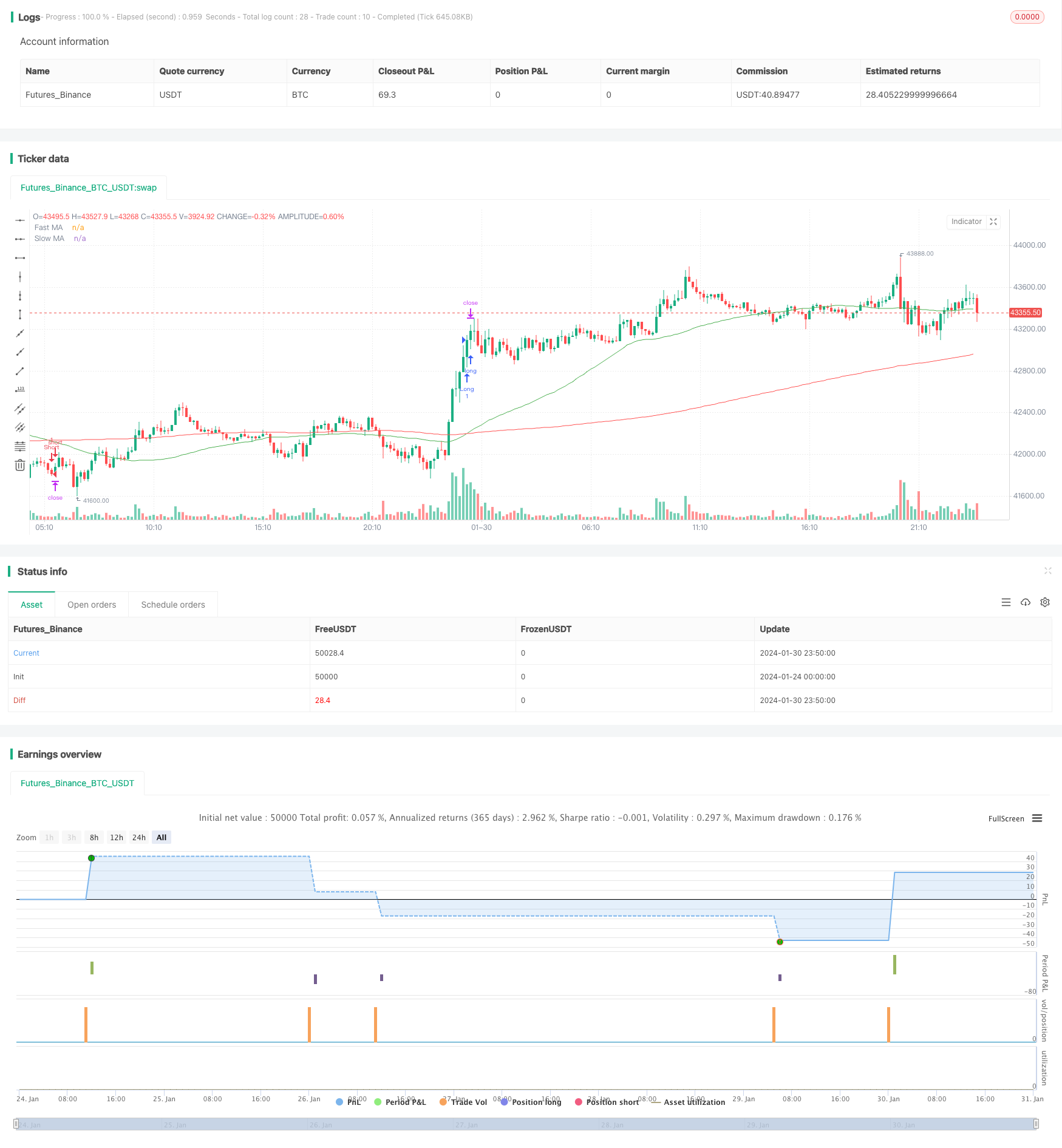
概述
该策略通过计算快速移动平均线(Fast MA)和慢速移动平均线(Slow MA)并进行比较,来判断市场趋势方向,实现跟踪趋势进行长仓或短仓。当快速移动平均线上穿慢速移动平均线时,做多;当快速移动平均线下穿慢速移动平均线时,做空。同时设置止损和止盈,控制风险。
原理
该策略的核心逻辑是基于移动平均线的金叉死叉。移动平均线能很好地反映市场平均价格的变化趋势。快速平均线长度较短,能快速响应价格变化;慢速平均线长度较长,代表了市场更大程度的趋势方向。当快速平均线上穿慢速平均线时,说明行情开始进入多头趋势;当快速平均线下穿慢速平均线时,说明行情开始进入空头趋势。
具体来说,该策略中分别计算长度为50周期和200周期的快速和慢速移动平均线。在每根K线收盘时,判断快速移动平均线是否上穿或下穿慢速移动平均线。如果发生上穿(黄线上穿红线),则在下一根K线开盘时以市价进入多单;如果发生下穿(黄线下穿红线),则在下一根K线开盘时以市价进入空单。
进入仓位后,会TrailStop来跟踪止损,锁定利润。此外还设置了基于ATR的值来判断止损位和止盈位。
优势
这是一个较为典型的趋势跟踪策略,具有以下优势:
- 使用移动平均线判断趋势方向准确性较高,胜率较好
- 采用不同速度均线组合,可以有效过滤市场噪音,捕捉主要趋势
- 设置止损止盈位,可以控制单笔损失,增加盈利概率
- 回测效果良好,最大回撤和夏普率接受水平
- 策略逻辑简单易理解,参数调整灵活,适合普通交易者
风险
该策略也存在以下风险:
- 当市场出现剧烈波动时,移动平均线生成的信号可能滞后,易受假突破影响
- 止损或止盈设定不当可能带来亏损或失利
- 过于依赖参数设定,参数不当会大幅影响策略效果
- 无法完美避免价格探头和回调带来的小亏损
- 没有考虑基本面和重大新闻事件对市场的影响
对应解决方法:
- 合理评估和设定移动平均线周期参数
- 采用自适应止损和止盈方式,避免人工设置错误
- 通过复杂度分析和回测优化参数
- 适当放宽止损范围,加大仓位规模
- 结合基本面分析和重大事件,制定应对方案
优化方向
该策略还存在进一步优化的空间:
- 增加多种周期的移动平均线组合,形成多组信号
- 增加成交量,波动率等指标来确认趋势信号准确性
- 采用机器学习方法来动态优化参数
- 设置自适应的止损止盈机制
- 考虑结合市场情绪,投资者注意力等指标
- 测试不同品种的通用性
- 结合更多复杂的突破指标或模型
总结
总的来说,该策略通过简单的移动平均线金叉死叉来判断和跟踪市场趋势,以及合理的止损止盈来控制风险,是一个易于实施的趋势跟踪入门策略。值得进一步对参数,止损机制,优化方法等进行研究和优化,使策略效果更加优异。
策略源码
/*backtest
start: 2024-01-24 00:00:00
end: 2024-01-31 00:00:00
period: 10m
basePeriod: 1m
exchanges: [{"eid":"Futures_Binance","currency":"BTC_USDT"}]
*/
// This Pine Script™ code is subject to the terms of the Mozilla Public License 2.0 at https://mozilla.org/MPL/2.0/
// © KasperKvist
//@version=4
strategy("EURCHF Smart Money Strategy", overlay=true)
// Input Parameters
fastLength = input(50, title="Fast MA Length")
slowLength = input(200, title="Slow MA Length")
riskRewardRatio = input(2, title="Risk-Reward Ratio")
// Calculate Moving Averages
fastMA = sma(close, fastLength)
slowMA = sma(close, slowLength)
// Strategy Conditions
longCondition = crossover(fastMA, slowMA)
shortCondition = crossunder(fastMA, slowMA)
// Execute Strategy
strategy.entry("Long", strategy.long, when = longCondition)
strategy.entry("Short", strategy.short, when = shortCondition)
// Set Stop Loss and Take Profit
atrValue = atr(14)
stopLoss = atrValue * 1
takeProfit = atrValue * riskRewardRatio
strategy.exit("ExitLong", from_entry="Long", loss=stopLoss, profit=takeProfit)
strategy.exit("ExitShort", from_entry="Short", loss=stopLoss, profit=takeProfit)
// Plot Moving Averages
plot(fastMA, color=color.green, title="Fast MA")
plot(slowMA, color=color.red, title="Slow MA")